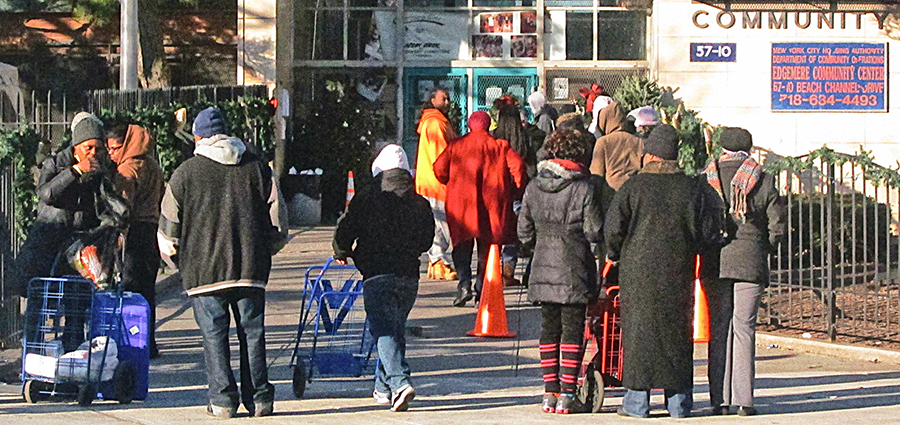

Food lines still needed weeks after hurricane struck.WW photo: G. Dunkel
The governors of New York, New Jersey and Connecticut came up with a $60 billion figure for the damage Hurricane Sandy did to their states and what it would cost to limit damage done by future storms. They asked Congress for the money and the Senate passed the bill Dec. 28. But it is not clear that the House will take it up, given the struggle over the “fiscal cliff.”
Very little of the damage done by Sandy to working and poor people will be compensated by this money, whenever it comes. This damage has been ignored, miscalculated or deemed irrelevant by government entities and the corporate-owned media. Immigrants, even those with legal permission to be in the United States, are disqualified from receiving any aid from the government. (Daily News, Dec. 18)
According to the Bureau of Labor Statistics, job losses in New York state due to Sandy are 30,000 for November. (New York Times, Dec. 20) This is a large number of jobs, but the BLS report notes that anybody who worked for even a single hour in November was not counted. So the real number of Sandy job losses is between 30,000 and 158,204, the number of individuals who filed initial claims for unemployment in November, nearly the number of claims made in January 2009 at the height of the recession.
The BLS figure for Sandy job losses in New Jersey is 8,100, but 138,661 — a record number of first-time claims for unemployment insurance — were filed.
The BLS will release a report at the end of January with better estimates. It is likely that some people who lost their job in November were rehired in December as some businesses reopened.
Millions of people in New Jersey and New York lost electricity, which meant they lost heat, hot water and refrigeration. Depending on whether they used gas or electricity, they couldn’t cook. Those in large apartment buildings, especially in New York City, lost water, which severely affected their sanitation.
Long Island Power Authority, generally regarded as a badly run utility, was unable to provide service to 90 percent of its customers. Most of its customers on Long Island got power back in a few weeks, but 11,000 LIPA customers in southeast Queens, in the Rockaways area of New York City, still didn’t have heat, hot water or power as of the third week of December, when the Queens Congregations United for Action did a survey.
QCUA also charged that as of Dec. 5 only 174 homes out of 38,000 homes and businesses on the Rockaway Peninsula had received help through Rapid Repairs, a city program to enable homeowners and renters to return to their homes.
While LIPA, a state controlled public authority, claimed it had nearly completely restored service, many residents of Far Rockaway at the end of December were still relying on community centers for food and hot meals.
Instead of help, eviction notices
Both Rapid Repair and the Federal Emergency Management Agency grants, by a decision of New York’s billionaire mayor, Michael Bloomberg, did not cover mold removal.
Dr. Natasha Anandaraja, a pediatrician at New York’s Mount Sinai Hospital, told the Daily News, “We’re concerned about children developing respiratory illnesses due to the cold, wet and moldy surroundings.” Many of the homes and apartments, especially in the Rockaways, without heat and electricity, are filled with mold, plaster dust and asbestos. (Dec. 19) The Star Ledger, which generally focuses on New Jersey news, also made similar warnings about dwellings there.
The New York City Housing Authority shamefully distinguished itself by sending process servers door-to-door with eviction notices while its buildings were without power, water, heat, elevators or gas. At the same time, it claimed it could not verify the status of the elderly, disabled and sick people living in its buildings who hadn’t been able to evacuate in the one day they were given by the city.
“It’s really ridiculous,” Edward Josephson, director of litigation for NYC Legal Services, stated. “At the very time they were unable to send people out there to see if people were dying or not, they were able to send people to serve notice of evictions.” (Daily News, Dec. 23)
Nearly 80,000 NYCHA tenants in Red Hook, Coney Island and the Rockaways lost basic services for weeks and their landlord didn’t deign to tell them when their buildings would be returned to normal. While tenants in some large, privately owned projects like Stuyvesant Town have already gotten rent abatements, there has been nary a word from NYCHA.
The effects of Hurricane Sandy make it clear that working and poor people need organizations that will fight for their interests on a broad front.
North Philly Peace Park gathering After a federal court hearing on an anti-immigration bill early…
Supporters of Palestine in Hoboken, New Jersey, were outraged when they found out that the…
Philadelphia Friends, family, fellow union members and community activists gathered at the Octavius Catto statue…
The Trump regime’s decision to lift sanctions on Syria exposes the true purpose of sanctions:…
Download the PDF Black and white version Nakba Day action hits Citibank Blue Bottle baristas…
Protesters rallied and marched on May 10 in Bay Ridge, Brooklyn, in commemoration of the…